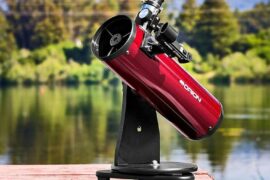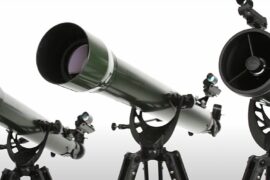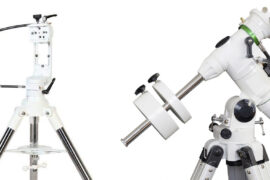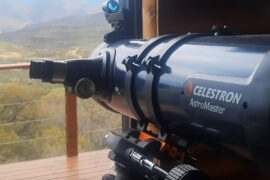Celestron has two entry-level series for amateur astronomers, the AstroMaster and the PowerSeeker telescopes. As a beginner, it can be hard to differentiate between them as they look quite similar when you look at their specifications.
In this article, we’ll compare them both so that you can better understand the advantages of each one and decide which is a better fit for your needs.
Celestron AstroMaster series
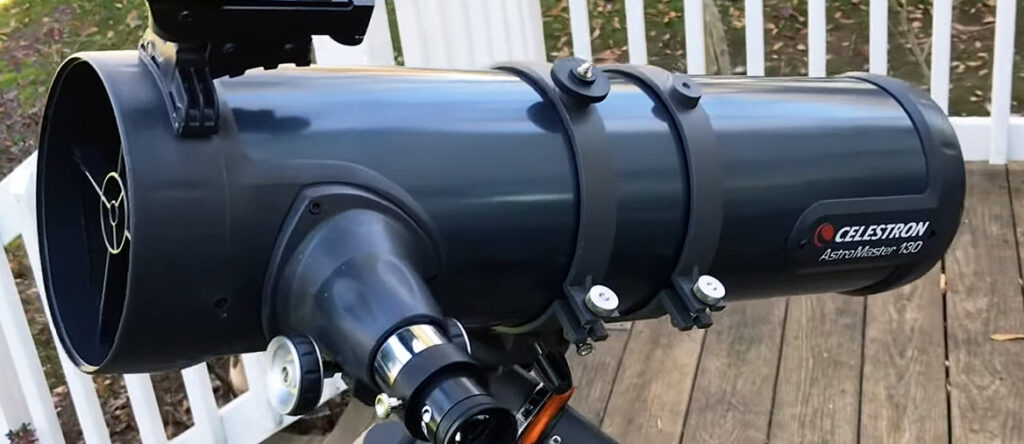
The AstroMaster series is the main brand the company has for amateur astronomers. It has refracting and reflector telescopes in the 60mm to 130mm aperture range.
If you are really new to astronomy, check out these articles on the pros and cons of refracting and reflecting telescopes to learn the benefits of each, and this one where I explain why aperture is the most important specification for a telescope.
The lineup of the AstroMaster series is comprised of the following models:
Refractors
- AstroMaster 70EQ
- AstroMaster 70AZ
- AstroMaster 80AZS
- AstroMaster 90EQ
- AstroMaster 90AZ
- AstroMaster 102 AZ
Reflectors (Newtonians)
- AstroMaster 76EQ
- AstroMaster 114EQ
- AstroMaster 130EQ
- AstroMaster 130EQ-MD
These telescopes are well-known for their characteristic dark-blue design, black lens covers, and orange accents. Celestron is one of the brands that is most recognized for its industrial design. Some people like it, and some people don’t, but you can always tell Celestron products apart.
The AstroMaster series has high-quality optics and the products are fairly priced, generally in the middle of the pack when compared to similarly specced telescopes of other brands.
The stars of the lineup are in my humble opinion, the AstroMaster 70AZ – which I recommended in our guide about the best refractor telescope for beginners and best telescope for teenagers – for its great value as a starting telescope, and the AstroMaster 130 EQ because it is one of the better performing reflectors in its range.
Celestron PowerSeeker series
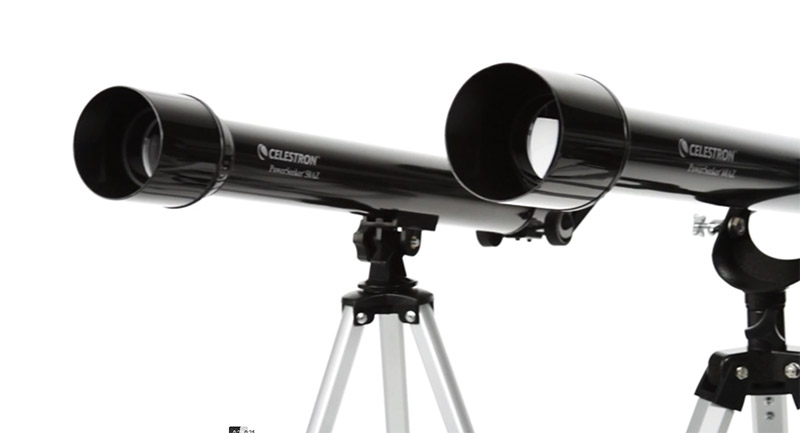
The PowerSeeker series is Celestron’s budget brand. But it is well made because it doesn’t cut corners in the optic elements. In fact, the mirrors and lenses are exactly the same as the ones in the AstroMaster series.
Instead, the PowerSeeker reduces slightly the focal length of the telescopes, it has a more sober outer design, and it comes bundled with mounts that use a more standardized design instead of the proprietary Celestron cg-3 models.
What’s best is that some users actually prefer these mounts and the smaller focal lengths offer some advantages for deep space observing. So, with the PowerSeeker you don’t feel like you are buying a lower-quality item because you are getting the same optic quality, it simply has a different set of benefits.
The Celestron PowerSeeker line has the following models:
Refractors
- Celestron PowerSeeker 50AZ
- Celestron PowerSeeker 60AZ
- Celestron PowerSeeker 60EQ
- Celestron PowerSeeker 70AZ
- Celestron PowerSeeker 70EQ
- Celestron PowerSeeker 80AZS
- Celestron PowerSeeker 80EQ
Reflectors (Newtonian)
- Celestron PowerSeeker 114EQ
- Celestron PowerSeeker 127EQ
As you can deduce from the list, the PowerSeeker line focuses more on telescopes with a smaller aperture and compact tubes. The best example of this is the PowerSeeker 80AZS which is an ultra-portable specifically built for travel.
AstroMaster vs PowerSeeker differences and similarities
These are the main differences and similarities between the AstroMaster and the PowerSeeker series. Please note that these are generalizations as the individual models might vary depending on their target users.
- They both have the same optics. I have compared an AstroMaster 70AZ and a PowerSeeker 70AZ side by side and I didn’t notice any difference in quality. Some people the AstroMaster has slightly better optics but I’m 99% sure it’s just a placebo effect due to the outer design, and slightly higher price or because they are looking specifically at planets and longer focal lengths perform a tiny bit better for planetary viewing. But the lenses are the exact same.
- AstroMaster has a distinct design with the classic Celestron orange accents. The PowerSeekers have a more sober look.
- The EQ PowerSeekers use standard eq-2 mounts. The AstroMasters use their proprietary cg-3 mounts. The jury is still out on which one is better. It generally comes to a matter of personal preference.
- The PowerSeekers have shorter focal lengths generally.
- The AstroMasters’ laser pointer is fixed. The PowerSeekers come with a standard 5*24 finderscope
- The PowerSeekers are built in smaller apertures.
- The AstroMaster series has more options for reflectors.
- Some PowerSeekers come with a more complete set of accessories than the AstroMasters which adds a lot to their value.
So, which one is better?
Honestly, they are both solid choices and it is hard to go wrong with either. Which one is a better fit for you is going to depend more on your specific needs, objectives, and budget.
But if you reaaaally want an answer. Go with the AstroMaster. The longer focal length makes them perform slightly better on planetary viewing which will be your main targets for telescopes in the 70-130mm aperture range.
Best AstroMaster Telescope
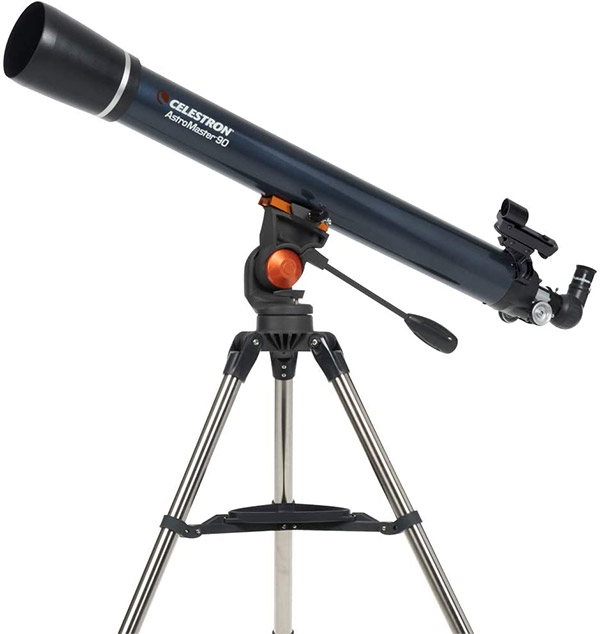
The very long focal length and larger aperture of this telescope make planetary viewing a delight. Perfect choice for beginners.
The AstroMaster 90AZ is the second largest refractor that Celestron makes. I chose it instead of the 102AZ for two reasons. 1) It has a better price-to-value ratio. 2) It has a longer focal length that results in a narrower field of view and a better experience for planetary and lunar viewing.
Refractors are much easier to use as a first telescope than Newtonians. They require pretty much no maintenance and have a shorter temperature acclimation time so you can use them almost immediately as soon as you get them out of storage.
The AZ mount is also generally better for beginners as it is almost “point and shoot”.
The only thing that I wish that would be included in the package but that you will have to get separately is a Barlow lens that is really going to complement the two included eyepieces. The Celestron Omni 2x would be a solid pick for that.
If you are getting started with stargazing it is hard to go wrong with one of the AstroMaster refracting scopes so if your budget is limited, the 70AZ or the 80AZ are also good options.
Best PowerSeeker Telescope
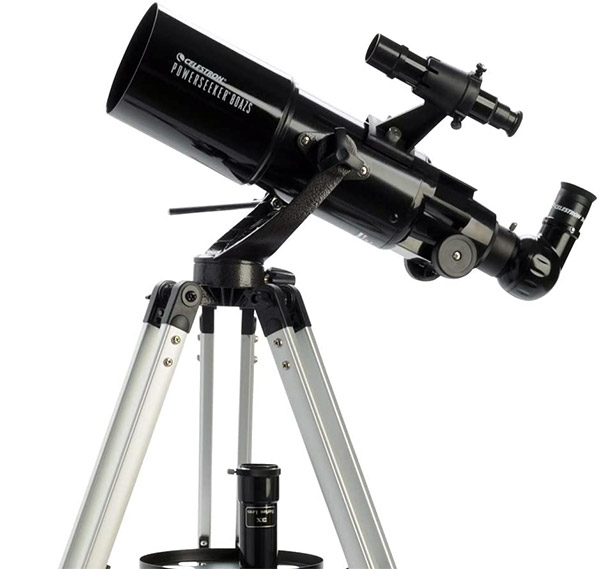
One of the best 80mm portable telescopes on the market. Solid optics for its small size. Great price to value ratio.
The area where the PowerSeekers shine is in their versatility and portability. This is why I’m choosing the PowerSeeker 80AZS here.
This is an ultra-portable telescope that barely weighs 10 pounds (4.5 kg) when fully assembled but still feels sturdy. It is the kind of telescope that you’d take on hikes or camping trips.
The “S” at the end of its name is for the Slow Motion Rod it has. This is a mechanism that some smaller telescopes use to keep the scope steady when you are making adjustments.
The aperture is on the smaller side at just 80mm, but it still manages to offer a good view of the Moon’s craters. You should also be able to see all the planets in the Solar system although don’t expect much detail past Mars.
Viewing the brighter galaxies and nebulae is possible under good sky conditions.
While this is not a super powerful telescope, it is a solid beginner’s device.
Summary
- The AstroMaster and PowerSeeker series are Celestron’s lineup of entry-level telescopes.
- The PowerSeekers are designed for a good price-to-value ratio while the AstroMasters are slightly more premium.
- They both have the same optics. The differences come in other areas.
Enjoyed this article?
Get daily 10-minute PDFs about astronomy to read before bed!
Sign up for our upcoming micro-learning service where you will learn something new about space and beyond every day while winding down.


